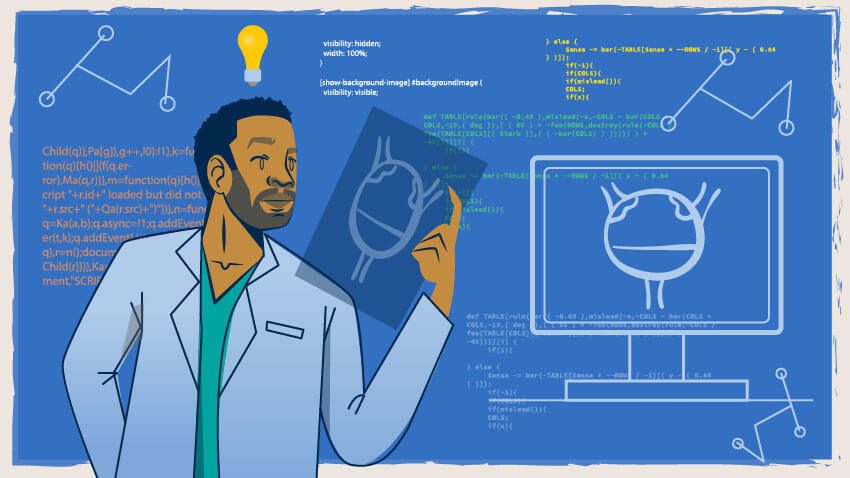Consultation with a machine learning tool helped providers determine more accurately whether patients had a complete response to chemotherapy.
Scientists from the University of Michigan investigated the impact of a computerized artificial intelligence (AI)-based decision support system (CDSS-T) on physicians’ diagnostic accuracy in measuring bladder cancer treatment response. The CDSS-T has the potential to increase diagnostic accuracy when evaluating the entire response of muscle-invasive bladder cancer to neoadjuvant chemotherapy before radical cystectomy.
An artificial intelligence-based method enhanced physicians’ assessments of whether patients with bladder cancer had a complete response to treatment before a radical cystectomy in small but multi-institutional research (bladder removal surgery).
Image Description: The graphical user interface for reading with and without our computerized decision support system (CDSS-T) for bladder cancer treatment response assessment.
Image Source: Computerized Decision Support for Bladder Cancer Treatment Response Assessment in CT Urography: Effect on Diagnostic Accuracy in Multi-Institution Multi-Specialty Study.
However, the researchers stress that AI is not a substitute for human expertise, and CDSS-T should not be used in that capacity.
“If you use the tool smartly, it can help you,” says Lubomir Hadjiyski, Ph.D., senior author of the paper and professor of radiology at the University of Michigan Medical School.
When a patient develops bladder cancer, doctors frequently remove the entire bladder to prevent cancer from spreading to other organs or locations. However, further evidence indicates surgery may not be required if a patient has no indication of disease following chemotherapy.
However, determining whether the lesion left after therapy is simply necrotic or damaged tissue as a result of treatment or whether cancer remains is challenging. The researchers questioned if artificial intelligence (AI) could assist.
“The big question was when you have such an artificial device next to you, how is it going to affect the physician?” said Hadjiyski. “Is it going to help? Is it going to confuse them? Is it going to raise their performance, or will they simply ignore it?”
Pre- and post-treatment scans of 157 bladder tumors were examined by fourteen physicians from various disciplines, including radiology, urology, oncology, and two fellows and a medical student. The doctors assigned ratings to three criteria that measured the extent of the response to chemotherapy, as well as a recommendation for the patient’s next treatment (radiation or surgery).
The providers then looked at a computer-generated score. Lesser ratings suggested a lower likelihood of complete chemo response, while higher values indicated a higher probability of complete chemo response. The providers have the option of revising or maintaining their ratings. Their final ratings were matched to tumor samples taken during their bladder removal procedures to ensure accuracy.
With the AI system, clinicians showed improvements in their assessments across various specializations and levels of experience. Those with less experience gained even more, to the point where they could diagnose at the same level as the more experienced individuals.
“That was the distinct part of that study that showed interesting observations about the audience,” says Hadjiyski.
The instrument helped academic institutions more than health centers that were solely focused on clinical therapy.
The research is part of a National Institutes of Health-funded initiative directed by Hadjiyski and Ajjai Alva, M.D., an associate professor of internal medicine at the University of Michigan, to develop and test biomarker-based tools for bladder cancer treatment response decision support.
For over more than two decades of performing AI-based studies to analyze different types of cancer and their treatment response, Hadjiyski has shown that machine learning tools can be valuable as a second opinion to assist clinicians in decision making, but they can also make mistakes.
The most interesting thing the researchers uncovered is that the computer makes mistakes on a different subset of cases than a radiologist would. Thus, if the tool is used correctly, it gives a chance to improve but not replace the physician’s judgment.
Although the results of this observer research demonstrate that our CDSS-T system has promise as a tool for clinicians to measure bladder cancer treatment response, further work is needed before it can be implemented in the clinic:
- First, it needs more performance enhancement.
- Second, the entire processing pipeline, including the auto-initialized cascaded level sets (AL-CALS) system for auto tumor segmentation and radiomic feature extraction, must be automated.
- Third, the CDSS-T system must be rigorously validated for generalizability using a diverse set of patient cases from several sites.
- Finally, as a preliminary stage before clinical translation, a well-controlled clinical study should be done by putting it into a real-world workflow to evaluate its effectiveness and efficiency.
Story & Image Source: Sun, D.; Hadjiiski, L.; Alva, A.; Zakharia, Y.; Joshi, M.; Chan, H.-P.; Garje, R.; Pomerantz, L.; Elhag, D.; Cohan, R.H.; Caoili, E.M.; Kerr, W.T.; Cha, K.H.; Kirova-Nedyalkova, G.; Davenport, M.S.; Shankar, P.R.; Francis, I.R.; Shampain, K.; Meyer, N.; Barkmeier, D.; Woolen, S.; Palmbos, P.L.; Weizer, A.Z.; Samala, R.K.; Zhou, C.; Matuszak, M. Computerized Decision Support for Bladder Cancer Treatment Response Assessment in CT Urography: Effect on Diagnostic Accuracy in Multi-Institution Multi-Specialty Study. Tomography 2022, 8, 644-656. https://doi.org/10.3390/tomography8020054
https://labblog.uofmhealth.org/health-tech/artificial-intelligence-helps-physicians-better-assess-effectiveness-of-bladder-cancer
Dr. Tamanna Anwar is a Scientist and Co-founder of the Centre of Bioinformatics Research and Technology (CBIRT). She is a passionate bioinformatics scientist and a visionary entrepreneur. Dr. Tamanna has worked as a Young Scientist at Jawaharlal Nehru University, New Delhi. She has also worked as a Postdoctoral Fellow at the University of Saskatchewan, Canada. She has several scientific research publications in high-impact research journals. Her latest endeavor is the development of a platform that acts as a one-stop solution for all bioinformatics related information as well as developing a bioinformatics news portal to report cutting-edge bioinformatics breakthroughs.












